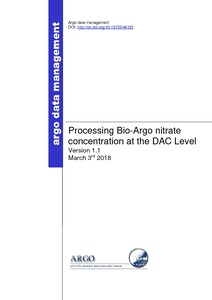Processing Bio-Argo nitrate concentration at the DAC Level. Version 1.1, March 3rd 2018.

View/
Average rating
votes
Date
2018Author
Johnson, Ken
Pasqueron De Fommervaul, Orens
Serra, Romain
D'Ortenzio, Fabrizio
Schmechtig, Catherine
Claustre, Herve
Poteau, Antoine
Status
PublishedPages
22pp.
Metadata
Show full item recordAbstract
The only method used to date to measure dissolved nitrate concentration (NITRATE) with sensors mounted on profiling floats is based on the absorption of light at ultraviolet wavelengths by nitrate ion (Johnson and Coletti, 2002; Johnson et al., 2010; 2013; D’Ortenzio et al., 2012). Nitrate has a modest UV absorption band with a peak near 210 nm, which overlaps with the stronger absorption band of bromide, which has a peak near 200 nm. In addition, there is a much weaker absorption due to dissolved organic matter and light scattering by particles (Ogura and Hanya, 1966). The UV spectrum thus consists of three components, bromide, nitrate and a background due to organics and particles. The background also includes thermal effects on the instrument and slow drift. All of these latter effects (organics, particles, thermal effects and drift) tend to be smooth spectra that combine to form an absorption spectrum that is linear in wavelength over relatively short wavelength spans. If the light.....
Resource URL
http://www.argodatamgt.org/documentation/Publisher
IFREMER for Argo Data ManagementVillefranche-sur-Mer, France
Document Language
enEssential Ocean Variables (EOV)
NutrientsMaturity Level
TRL 8 Actual system completed and "mission qualified" through test and demonstration in an operational environment (ground or space)Best Practice Type
Standard Operating ProcedureManual
DOI Original
10.13155/46121Citation
Johnson, K.; Pasqueron De Fommervault, O.; Serr, R.; D'Ortenzio, F.; Schmechtig, C.; Claustre, H. and Poteau Antoine (2018) Processing Bio-Argo nitrate concentration at the DAC Level. Version 1.1, March 3rd 2018. IFREMER for Argo Data Management, 22pp. DOI: http://doi.org/10.13155/46121Collections
 Repository of community practices in Ocean Research, Applications and Data/Information Management
Repository of community practices in Ocean Research, Applications and Data/Information Management